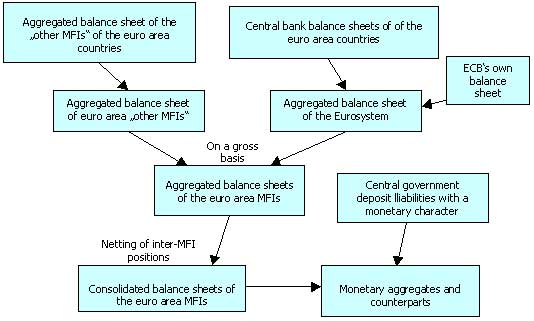The aggregated balance sheet and the consolidated balance sheet of the euro area Monetary Financial Institutions
The diagram below outlines the process leading from national submissions to the consolidated balance sheet of the euro area MFIs and to the euro area monetary aggregates. The balance sheets of the national 'other MFIs" sectors of the euro area countries are combined to form the aggregated balance sheet of the euro area 'other MFIs" sector. Similarly, aggregation of the balance sheets of the euro area national central banks and that of the ECB yields the aggregated balance sheet of the Eurosystem. These balance sheets are both compiled on a gross basis. The aggregated balance sheet thus includes assets and liabilities vis-a-vis other MFIs. For example, it includes deposits exchanged on the interbank markets or the liquidity periodically supplied to the banking system by the Eurosystem.
Consolidation implies the following: i) deposits with MFIs and loans to MFIs are netted out; and ii) currency in circulation and negotiable liabilities issued by the MFI sector (debt securities, money market paper and money market fund shares and units) are netted out with the amounts of such instruments held on the assets side by MFIs. As it is very difficult to identify the current holder of a negotiable financial instrument (to do so would imply monitoring all subsequent on-sales of the security), the amounts held outside the MFI sector can only be derived as a residual of the total issued, minus the corresponding holdings reported by MFIs as assets.
Finally, monetary aggregates are derived by adding to the monetary liabilities recorded on the consolidated balance sheet certain short-term deposit liabilities of the central government (Post Office accounts, national savings accounts and Treasury accounts), which have similar characteristics to short-term bank deposits.
The compilation of the consolidated balance sheet of the euro area MFIs
